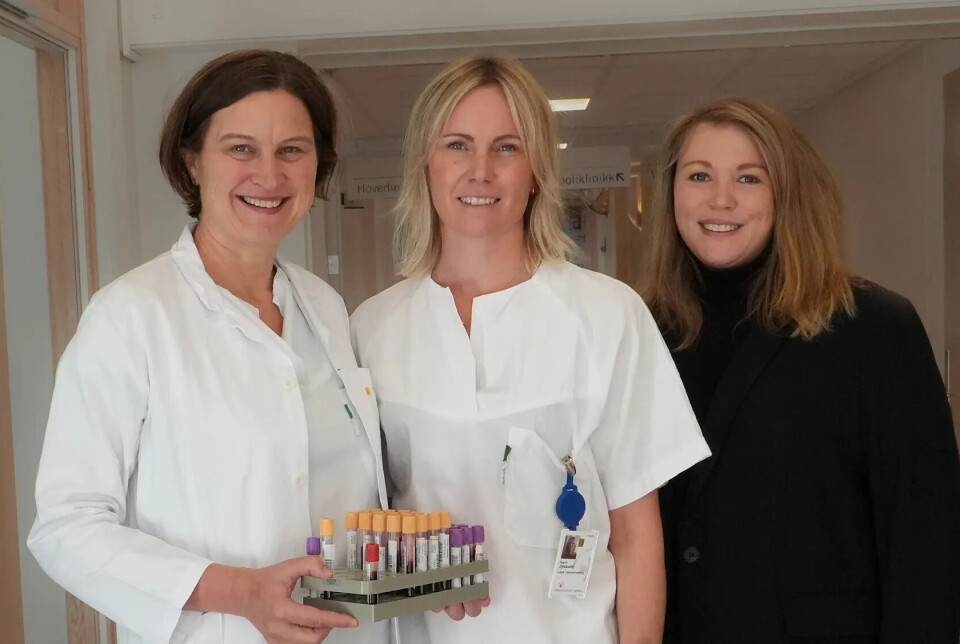She ensures that there is good flow in the research

Conducting clinical trials requires more than just researchers. Support personnel handle rules, applications and documents. They also contribute to good communication in the studies.
In the picture you see Camilla Skancke Mørstad. She is a research coordinator at the REMEDY research center at Diakonhjemmet hospital. She contributes to clinical trials going exactly as they should - to the benefit of the patients. (Photo: Nicolas Tourrenc / Diakonhjemmet hospital)
- I facilitate cooperation between different parties, says Camilla Skancke Mørstad. She is a research coordinator at Diakonhjemmet hospital.
In one of the projects, she helps researchers get the most out of biological medicines.
- Coordinators create good flow. That makes the research more efficient, says Silje Watterdal Syversen. She is a senior researcher at the REMEDY research center at the hospital.
Clinical research as part of the treatment
The government has a clear vision that clinical research should be part of patient care. Clinical research means research that is carried out on people.
- With us, this is already part of everyday life, says Mørstad.
Treatment studies examine the effectiveness and safety of various treatments. At Diakonhjemmet hospital, patients can quickly benefit from research.
- When we see that a treatment works, the patients can receive it quickly, says Syversen.
Better utilization of medicines
In 2023, Mørstad joined the project, SQUEEZE. In the Norwegian part called RA-DRUM, they look at how medicines can be adapted to the individual with arthritis.
- It's about squeezing more out of the medicines we already have, says Syversen, who is the project manager.
She emphasizes that coordinators are crucial to making large studies with collaboration between many environments work.
They follow up the studies and collaborate closely with national and international professional environments.
- We make sure that everything goes right, explains coordinator Mørstad.
Careful planning – a key to success
Everything must be ready before a study can start. European and Norwegian authorities must approve the study. This takes time.
Among other things, a protocol must be drawn up that describes how the study is to be carried out. It must also say something about who can participate and what will happen if unwanted incidents occur.
The application for approval is sent through the European Clinical Trials Information System (CTIS). It is a joint portal for applications and communication in the EU/EEA.
The study sites must follow the approved layout
For RA-DRUM, the team had to ensure that everything was ready before starting:
Among other things, they have ensured that the clinic is able to follow the protocol for the project. In order for all the participants in the study to be able to follow the same set-up, they have had a dialogue both with the hospitals in Norway and with the international actors.
- Everyone involved must know what must be in place before they start. Progress can stop if all the requirements are not met. My job is to ensure that everything runs smoothly, says Mørstad.
Round trip for national start-up
To get everyone involved in the study up and running, Mørstad and the team have meetings at 15 rheumatology departments.

- Some of the researchers who are involved in the project, together with me, have attended meetings from Kristiansand in the south to Tromsø in the north. It is exciting to see the results of the thorough preparatory work, says Mørstad.
Still a lot of work in the project
The project is now well under way in Norway and Sweden.
- In the future, we will ensure that the rest of the international partners can start the study with them. When all the study centers are up and running, the job will be to follow up the process of including patients. As a coordinator, I also work to ensure the quality of the data that is brought in, she says.
Mørstad is central to communication with the various centres. She can assist in the form of answering and passing on questions. She can also follow up on what needs to be done to carry out the study in a good way.
There are, for example, annual reports and applications for any changes to the study.
- Experiences we gain along the way can trigger the need for changes in the study. This requires an application for change to the appropriate authority.
Mørstad points out that when such changes have been approved and are to be implemented, it is important that this is communicated well to the various participating hospitals.
- We must ensure that the right personnel receive the information and also receive enough training to be able to carry out such changes. As coordinators, you are involved in the study throughout and follow the project from start to finish, says Camilla Skancke Mørstad.
The researchers include patients in the study until 31 December 2027.
Partners in the project
- Bethany Hospital
- Diakonhjemmet hospital
- Haugesund Sanitetsforening Rheumatism Hospital
- Helgeland Hospital
- Health Bergen
- Health Førde
- Health Møre and Romsdal
- Health Stavanger
- Martina Hansen's Hospital
- Nordland Hospital
- The Rheumatism Hospital
- Sørlandet Hospital
- St. Olav's hospital
- Østfold Hospital
- The University Hospital of Northern Norway
- Western bay





